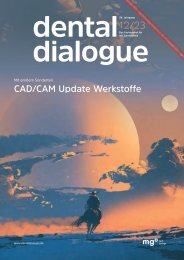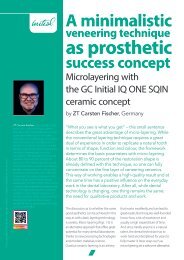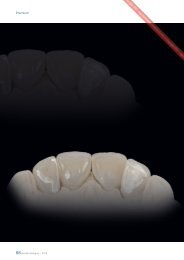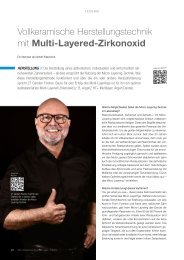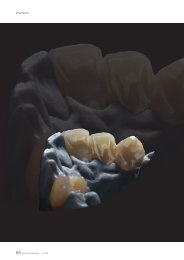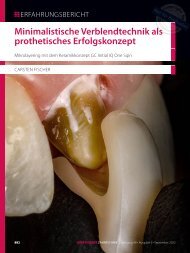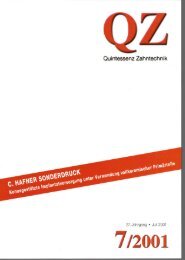Mikrobiologische Reinigung und Desinfektion Wirksamkeit einer dreistufigen Ultraschallbearbeitung Protokoll für CAD-CAM-Implantataufbauten
- No tags were found...
Create successful ePaper yourself
Turn your PDF publications into a flip-book with our unique Google optimized e-Paper software.
The Journal of Advanced Prosthodontics<br />
https://doi.org/10.4047/jap.2022.14.5.273<br />
sions were obtained:<br />
A three-step ultrasonic cleaning and disinfection<br />
process is reproducible and complies with the standardized<br />
reprocessing and disinfection specifications<br />
for custom one- or two-piece <strong>CAD</strong>-<strong>CAM</strong> implant<br />
abutments made of titanium or ceramic. The cleaning<br />
solution with the active ingredients chlorhexidine<br />
gluconate and cetrimide, followed by ethyl alcohol<br />
and medically pure water in the ultrasonic treatment,<br />
leads to effective bacterial decontamination. Ultrasonic<br />
reprocessing resulted in a substantial decrease<br />
of residual protein of less than 80 µg and a reduction<br />
in microbiota of more than 7 lg levels of colony-forming<br />
units for all abutment types, exceeding the effect<br />
required for disinfection.<br />
ACKNOWLEDGEMENTS<br />
The authors gratefully acknowledge Jochen Schlenker<br />
for his support and valuable advise as well as Patrick<br />
Mühlbeyer for his excellent technical assistance.<br />
The authors thank BEGO Medical GmbH for providing<br />
the test samples for the experimental investigation.<br />
REFERENCES<br />
1. Kapos T, Evans C. <strong>CAD</strong>/<strong>CAM</strong> technology for implant<br />
abutments, crowns, and superstructures. Int J Oral<br />
Maxillofac Implants 2014;29:117-36.<br />
2. Zarauz C, Pitta J, Pjetursson B, Zwahlen M, Pradies G,<br />
Sailer I. Esthetic outcomes of implant-supported single<br />
crowns related to abutment type and material: a<br />
systematic review. Int J Prosthodont 2021;34:229-49.<br />
3. Gehrke P, Bleuel K, Fischer C, Sader R. Influence of<br />
margin location and luting material on the amount of<br />
<strong>und</strong>etected cement excess on <strong>CAD</strong>/<strong>CAM</strong> implant abutments<br />
and cement-retained zirconia crowns: an in-vitro<br />
study. BMC Oral Health 2019;19:111.<br />
4. Ivanovski S, Lee R. Comparison of peri-implant and<br />
periodontal marginal soft tissues in health and disease.<br />
Periodontol 2000 2018;76:116-30.<br />
5. Rupp F, Gittens RA, Scheideler L, Marmur A, Boyan BD,<br />
Schwartz Z, Geis-Gerstorfer J. A review on the wettability<br />
of dental implant surfaces I: theoretical and experimental<br />
aspects. Acta Biomater 2014;10:2894-906.<br />
6. Canullo L, Tallarico M, Radovanovic S, Delibasic B,<br />
Covani U, Rakic M. Distinguishing predictive profiles<br />
for patient-based risk assessment and diagnostics<br />
of plaque induced, surgically and prosthetically triggered<br />
peri-implantitis. Clin Oral Implants Res 2016;27:<br />
1243-50.<br />
7. Welander M, Abrahamsson I, Bergl<strong>und</strong>h T. The mucosal<br />
barrier at implant abutments of different materials.<br />
Clin Oral Implants Res 2008;19:635-41.<br />
8. Canullo L, Micarelli C, Lembo-Fazio L, Iannello G,<br />
Clementini M. Microscopical and microbiologic characterization<br />
of customized titanium abutments after<br />
different cleaning procedures. Clin Oral Implants Res<br />
2014;25:328-36.<br />
9. Gehrke P, Tabellion A, Fischer C. Microscopical and<br />
chemical surface characterization of <strong>CAD</strong>/<strong>CAM</strong> zircona<br />
abutments after different cleaning procedures. A<br />
qualitative analysis. J Adv Prosthodont 2015;7:151-9.<br />
10. Gehrke P, Abazari C, Schlichter K, Fischer C, Duddeck<br />
D, Romanos GE, Weigl P. Qualitative and semi-quantitative<br />
assessment of processing-related surface contamination<br />
of one- and two-piece <strong>CAD</strong>/<strong>CAM</strong> abutments<br />
before and after ultrasonic cleaning. Materials<br />
(Basel) 2020;13:3225.<br />
11. Canullo L, Micarelli C, Iannello G. Microscopical and<br />
chemical surface characterization of the gingival portion<br />
and connection of an internal hexagon abutment<br />
before and after different technical stages of preparation.<br />
Clin Oral Implants Res 2013;24:606-11.<br />
12. Mishra PK, Wu W, Rozo C, Hallab NJ, Benevenia J,<br />
Gause WC. Micrometer-sized titanium particles can induce<br />
potent Th2-type responses through TLR4-independent<br />
pathways. J Immunol 2011;187:6491-8.<br />
13. Infection control recommendations for the dental office<br />
and the dental laboratory. ADA Council on Scientific<br />
Affairs and ADA Council on Dental Practice. J Am<br />
Dent Assoc 1996;127:672-80.<br />
14. ISO 17664-1. Processing of health care products - Information<br />
to be provided by the medical device manufacturer<br />
for the processing of medical devices - Part<br />
1: Critical and semi-critical medical devices. International<br />
Standard Organization (ISO); Geneva; Switzerland,<br />
2021.<br />
15. Park JH, Olivares-Navarrete R, Baier RE, Meyer AE,<br />
Tannenbaum R, Boyan BD, Schwartz Z. Effect of<br />
cleaning and sterilization on titanium implant surface<br />
properties and cellular response. Acta Biomater 2012;<br />
282 https://jap.or.kr



